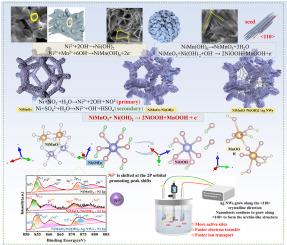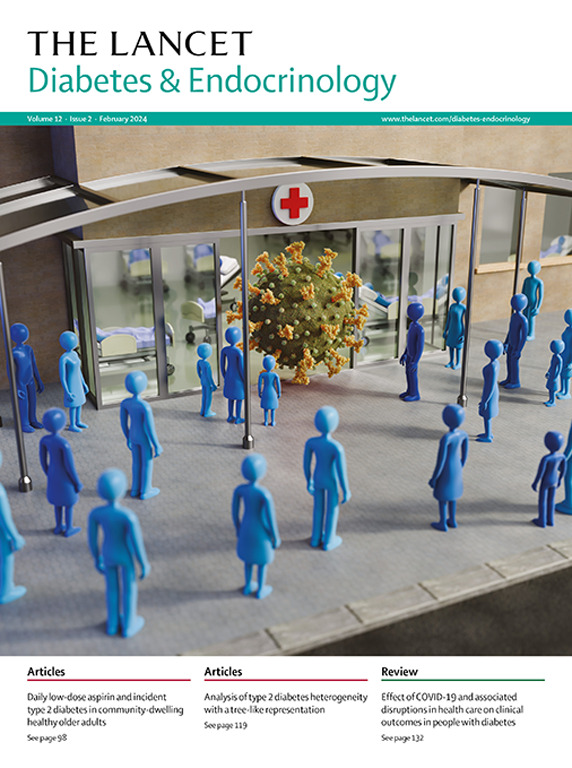具有原位生长导电三维网络的镍锰银氮氧化物复合物电极材料,通过提高 Ni2+ 增强超级电容性能
IF 44
1区 医学
Q1 ENDOCRINOLOGY & METABOLISM
引用次数: 0
摘要
功率密度是影响电极材料性能的重要因素之一,而离子/电子传输和团聚堆积问题则阻碍了电极材料的性能。本研究通过引入 Ag NWs 合成了一种新型 3D NiMnO3/Ni(OH)2/Ag NWs 复合材料。Ag NWs的引入协同影响了NiMnO3/Ni(OH)2/Ag NWs复合材料的晶体结构和微观形态。Ag NWs 独特的五孪晶结构促进了 (110) 和 (101) 晶面的增强,从而诱导了 Ni 2p3/2 的移动,导致复合材料中 Ni2+ 浓度的显著增加。这确保了大量的离子吸附位点,生成了有利于活性反应的材料。这种新结构增加了活性位点的密度,建立了导电网络,优化了电子和离子传输路径,大大降低了电极-电解质界面的扩散阻力,提高了电荷转移效率,从而有效提高了材料的比容量和能量密度。在电流密度为 0.01 A-cm-2 时,镍锰酸锂/镍(OH)2/银 NWs//AC 器件显示出 350.478 mAh-g-1 的显著比容量;在功率密度为 1699.871 W kg-1 时,其 Ragone 图显示出 81.107 Wh kg-1 的峰值能量密度。此外,在功率密度为 8490.072 W kg-1 时,它的能量密度为 60.532 Wh kg-1。这项研究探索了三维结构电极材料的设计和应用,有效提高了材料的比容量,为进一步提高超级电容器的能量密度提供了新思路。本文章由计算机程序翻译,如有差异,请以英文原文为准。

NiMn-Ag NWs Complexes Electrode Material with In Situ Grown Conductive 3D Networks for Enhanced Supercapacitive Performance by Boosting Ni2+
Power density is one of the important factors affecting the performance of electrode materials, which is hampered by ion/electron transport and agglomeration build-up problems. In this study, a novel 3D NiMnO3/Ni(OH)2/Ag NWs composite is synthesized via the introduction of Ag NWs. The introduction of Ag NWs synergistically influences the crystal structure and micro-morphology of the NiMnO3/Ni(OH)2/Ag NWs composite. The unique pentatwinned structure of Ag NWs facilitates the enhancement of the (110) and (101) crystal planes, which induces the movement of Ni 2p3/2, leading to a significant increase of Ni2+ concentration in the composites. This ensures an abundance of ion adsorption sites, generating materials conducive to reactive activity. This new structure increases the density of active sites and establishes a conductive network, which optimizes the electron and ion transport paths, greatly reduces the diffusion resistance at the electrode-electrolyte interface, and improves the charge transfer efficiency, thus effectively increasing the specific capacity and energy density of the material. The NiMnO3/Ni(OH)2/Ag NWs//AC device exhibits a remarkable specific capacity of 350.478 mAh·g-1 at a current density of 0.01 A·cm-2, and its Ragone plot reveals a peak energy density of 81.107 Wh kg-1 at a power density of 1699.871 W kg-1. Additionally, it achieves an energy density of 60.532 Wh kg-1 at a power density of 8490.072 W kg-1. This study explores the design and application of 3D structured electrode materials, which effectively improves the specific capacity of the materials and provides a new idea to further improve the energy density of supercapacitors.
求助全文
通过发布文献求助,成功后即可免费获取论文全文。
去求助
来源期刊

The Lancet Diabetes & Endocrinology
ENDOCRINOLOGY & METABOLISM-
CiteScore
61.50
自引率
1.60%
发文量
371
期刊介绍:
The Lancet Diabetes & Endocrinology, an independent journal with a global perspective and strong clinical focus, features original clinical research, expert reviews, news, and opinion pieces in each monthly issue. Covering topics like diabetes, obesity, nutrition, and more, the journal provides insights into clinical advances and practice-changing research worldwide. It welcomes original research advocating change or shedding light on clinical practice, as well as informative reviews on related topics, especially those with global health importance and relevance to low-income and middle-income countries. The journal publishes various content types, including Articles, Reviews, Comments, Correspondence, Health Policy, and Personal Views, along with Series and Commissions aiming to drive positive change in clinical practice and health policy in diabetes and endocrinology.
 求助内容:
求助内容: 应助结果提醒方式:
应助结果提醒方式:


